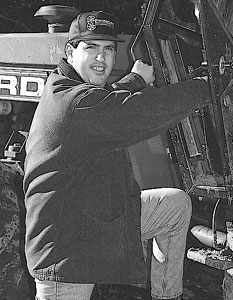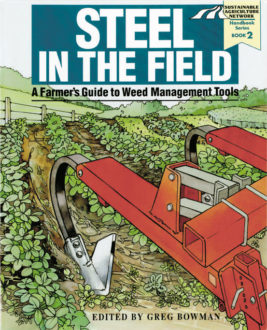
Horticultural Crops: The Farmers
Diversified Oregon Grower Matches Tools to the Task
Bill Chambers
Corvallis, Oregon
- 1,300 acres
- sandy loams to silty clay loam soil
- grass and sugar beets for seed
- 38 inches precipitation annually, dry summers
- wheat; squash/pumpkins, sweet corn and broccoli for processing
Weed management highlights
Strategies: crop rotation (irrigated and non-irrigated, early- and late-seeded)... cover crops to suppress weeds... modified stale seedbed tillage-cultivation-planting sequence... hand-hoeing
Tools: flex-tine weeder... rolling cultivator... rotary power harrow... high-residue cultivator... low-residue cultivator... sweeps, disks, tines and shanks to mix and match as conditions require
Bill Chambers isn't alone when planning weed management strategies for his vegetables, sugar beets, wheat and grass seedstock at Stallbush Island Farm. He has crop specialists and mechanics on staff to watch conditions and respond with appropriate tool combinations. But it's Chambers who brings an economist's rigor to redesigning whole-farm cropping systems that optimize on-farm resources and get more from his weed-killing tools.
Chambers evaluates the long-term costs and benefits of steel tools and cultural practices, calculating maintenance, labor and crop niches. He uses virtually all of his weed management tools for several rotation situations - another way that crop diversity works in his favor. He has abundant farm labor to hand-weed pumpkins, a practice which keeps field clean, pumpkins healthy, soil pesticide-free and wages circulating in his community.
He already raises broccoli, sweet corn and pumpkins without herbicides and is decreasing his dependence on the sprays wherever else he can. Driving his quest for new strategies and tools is a nearly empty chemical arsenal, as there are few herbicides still labeled for use in his crops. 'In pumpkins, I had one broadleaf label and two grass herbicides,' he explains. 'They're designed to work in Midwest weather and Midwest soils. They don't always work here and they're very expensive. So alternatives pay.'
He rotates the moisture cycle on each field, irrigating for two years then farming dryland style for one. His crop sequence is sugar beets for seed, pumpkins, sweet corn, perennial ryegrass for seed, broccoli, pumpkins then wheat or grass for seed. He sometimes substitutes snap beans for broccoli. Chambers uses grass/legume cover crop mixes. His main one is oats planted at 60 pounds per acre with common vetch (Vicia sativa L.) at 30 pounds per acre as soon as possible following previous crops.
To kill the covers in the April 10 to May 10 window, he flail mows the cover within 1.5 to 2 inches of the ground, then waits about 30 days before he begins tillage. Dry matter deposited by the covers is about 7,500 pounds per acre. If he doesn't have at least two weeks to allow the residue to break down, he will use Roundup herbicide.
A favorite tool is his 30-foot Lely flex-tine weeder, which resembles a light, high framed harrow and works as a light broadcast cultivation tool. The four ranks of coiled tines - each about the diameter of a thin pencil and 15 inches long - rake the soil surface to pull out and expose sprouting and emerging weeds. He waits until crops are established well enough to survive some tissue damage. He uses a 70-hp tractor which gives good stability and control on moderately flat fields.
Chambers had only read about the weeder when he bought his model in 1993. He quickly realized how well it would fit into his operation.
He runs the weeder preemerge diagonally over fields seeded with sweet corn and pumpkins fairly fast - 'as fast as you can hang on is fine.' He goes through again as needed, driving more slowly up and down the rows once crops have three or four true leaves. 'This time, you have to get off, get down next to the row and look carefully at the crop,' he says. He adjusts tractor speed, coil tension and tine depth to kill weeds but protect the crop. The Lely's tines work best when weeds are in the vulnerable white-root stage, before they have any true leaves.
Chambers says each operator has to develop a 'gut instinct' for what constitutes tolerable crop damage by the tines. 'Sweet corn plants are fine if the growing point is undamaged, despite torn leaves. Pumpkins can take a lot higher damage than you think,' he has found. 'In some passes I feared that I had reduced plant population by 25 percent, but a week later you couldn't tell I'd been through.' His target weeds in pumpkins are sow thistle, redroot pigweed, nightshade and shepherd's purse.
He's learned not to disturb pumpkin seedlings for a 10-day period after germination. The plant is brittle and vulnerable in this stage. Once it reaches the three-leaf stage, it is robust enough to lose a leaf and keep growing. He can knock out up to 15 percent of the young plants with no yield penalty. Pumpkins, like soybeans, have a compensatory growth cushion provided by extra growth of the neighboring plants.
'I'm in transition from a chemical-intensive system to a management intensive system that's more sustainable - but also more demanding.' - Bill Chambers
The Lely and other flex-tine weeders designed for row crops have individually retractable tines. Chambers uses this feature when he cultivates growing broccoli and sugarbeets, lifting tines up over the row and away from contact with the tender plants. He sometimes runs into trouble, however, in the sugarbeets because of differences in germination between pollinator and seed rows that demand different settings for best weed control close to the row.
He later bought a second, smaller 15-foot Lely weeder for postemergent weeding. The narrower width improves the evenness of penetration in his river-bottom fields, which have swails up to 15 feet deep. Both his weeders have gauge wheels to help even out penetration from side to side of the tool. It takes almost a year for beets to set seed, requiring continuous weed management. His tine weeder cuts one - and sometimes two - herbicide applications from the traditional three-spray crop. Control of volunteer vetch, wild oats, Canada thistle and catchweed bedstraw are critical to produce high-quality, weed seed-free beet seed. Volunteer grains and well-rooted grasses are tough early competitors that often survive the weeder, he cautions. He cleans up these weeds while the beets are in a dormant phase by broadcasting a herbicide mix or by hand hoeing minor infestations. He adds 2 pounds of boron per acre to enhance the herbicide action.
Chambers has tried using the Lely weeder postemergence in winter wheat. To avoid disease pressure in wheel tracks due to compressed soil, he waits until after the first freeze to plant. It takes a 'tricky dance with the weather' to seed then weed the newly emerged grain crop before winter rains set in.
Other tools he uses are:
- Box-beam cultivator toolbar (4 inches square, 15 feet long) and an array of steel weeding tool choices - narrow points for maximum penetration, wide sweeps for undercutting the surface, cutaway disks large and small to move soil away from or toward the row, Lilliston rolling cultivator spider gangs, subsoiler points to remove tire tracks and duckfoot sweeps to combine good soil entry and surface action.
- Bi-directional, 90-hp Ford 276 tractor. Seated facing the cab end and driving down the row cab-end forward gives him the visibility advantages and immediate turning response of a mid-mount tool. 'By looking right into a tool that I'm pushing forward, I get instant feedback so I can make faster decisions,' Chambers says. He travels 4 to 5 mph.
- Lely Roterra rotary harrow. Designed as a PTO-powered secondary tillage tool, the Roterra works well to eliminate weeds and loosen soil where a well-tilled seedbed is needed. It uses pairs of sturdy vertical club tines 9 to 11 inches tall to stir the soil by spinning horizontally. The tops of the tines are mounted to a round base secured in series across the width of a flat-frame gearbox.
Chambers uses the Roterra to prepare soil for all crops except his covers and is careful to replace tines and other moving parts each 7,500 acres of use - about once every three years for him, given the Stallbush Farm's multiple passes and crops.
- IH 140 offset, high-clearance tractor. The 30-hp tractor - built for cultivation - has its engine offset to the left and a frame for belly-mounting cultivators between the front and rear axles, in front of the driver. Chambers uses the vintage mid-'50s tractor to run cultivators up to 10 feet wide. He stays in fairly flat fields because the rigid mount shanks have limited ability to flex over uneven terrain.
Chambers wants to take computer-assisted optical pattern recognition technology now used for pinpoint herbicide spraying and apply it to mechanical weed control. He's working on an in-row, up-and-down sweep assembly that will travel between pumpkin rows, raise up quickly upon reaching a pumpkin plant, then quickly drop back down. The software will be able to distinguish between green leafy weeds and green leafy pumpkins, a job that now only humans can do.
'I spend about $32,000 a year for weed control in pumpkins - 400 acres at $80 dollars per acre in a weedy season,' Chambers explains. A machine that reduces his costs by two thirds would provide $21,312 in annual savings. Capitalizing the purchase over five years at 8 percent would allow him to spend $85,000 for the tool, he calculates.
That's high-priced steel by traditional standards, but it illustrates Chambers' commitment to his 'computer analogy' of weed control systems. He likens the toolbar and tractor to the electronic hardware, while sweeps, knives and tines are the software that the operator has to knowledgeably select, configure and apply. Without a deep understanding of soils, crops, and costs, a farmer will be at a loss to make even the right tool compute.
